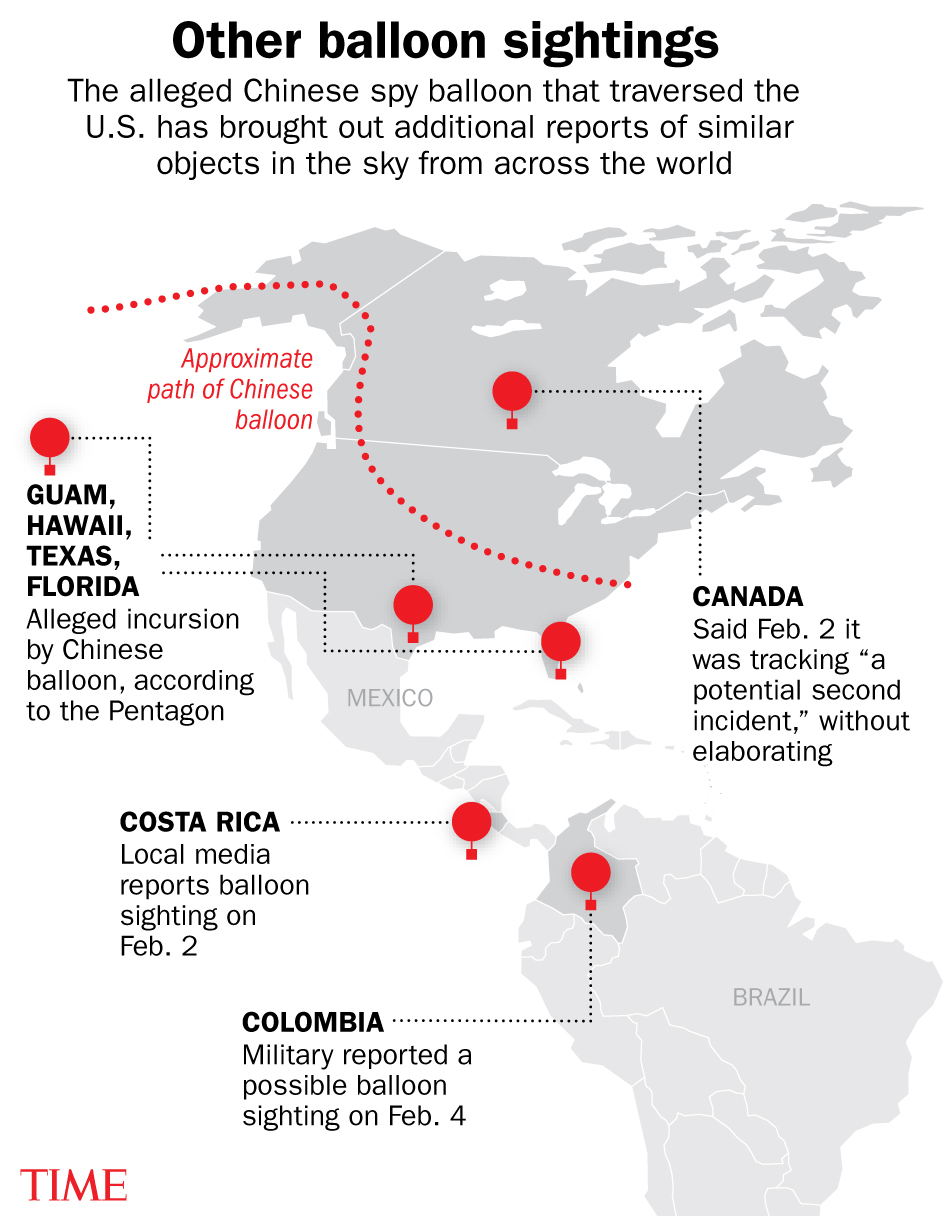The alleged Chinese spy balloon that was shot down after traversing the continental U.S. has raised questions about whether other airships like it have floated into other countries’ airspace in the past.
At least four other governments have reported additional instances of possible surveillance balloons. U.S. Defense officials also reported multiple previous sightings of these devices in recent years.
But, few details are publicly known about many of these sightings. These balloons typically fly much higher than aircraft; the most recent balloon in the U.S. was hovering at an altitude of 60,000 ft.—nearly twice the altitude of most commercial aircraft.
Experts note that it can be hard to detect these kinds of balloons if you’re not looking for them. Unlike missiles and airplanes, military radar operators like the U.S. Northern Command and the North American Aerospace Defense Command (NORAD) aren’t as attuned to picking up inflatable airships.

Here’s what we know about the other possible spy balloon sightings.
Other U.S. incursions
General Glen VanHerck, commander of U.S. Northern Command and the North American Aerospace Defense Command (NORAD), confirmed Monday the Chinese government previously sent surveillance balloons above the U.S. that went undetected. “Every day as a NORAD commander, it’s my responsibility to detect threats to North America,” he said at a briefing. “I will tell you that we did not detect those threats. And that’s a domain awareness gap that we have to figure out.”
Despite acknowledging that there were other possible incursions, the Pentagon has released few details, including specifics of when they happened.
Rep. Michael Waltz (R-Fla.), a member of the House Armed Services Committee, told the Washington Post that lawmakers and military officials spoke on Saturday to discuss previous instances of similar surveillance balloons in the U.S. During the Trump Administration, a Chinese spy balloon reportedly made its way to Texas and Florida, military officials said Sunday. Another such balloon made it to Guam. One crashed off the coast of Hawaii four months ago, Fox News reported.
Balloon reported over Latin America
U.S. officials also said Friday that a Chinese balloon had been spotted somewhere over Latin America but did not specify an exact location.
Colombia’s military said Feb. 4 that it had spotted a balloon-like object in its airspace. Local media in Costa Rica reported that hundreds of people had spotted a balloon in the sky on Feb. 2 that was similar to the one the U.S. identified over Montana.
Over Canada
Canada flagged on Feb. 2 that it was tracking a “potential second incident.” The balloon shot down by the U.S. had previously been in Canadian airspace before arriving in the U.S.
In the most recent incident in the U.S., a Chinese spy balloon was spotted about 60,000 feet over Billings, Montana on Feb. 1. It passed through Alaska and Canada, as well as parts of Idaho and Missouri, before the military shot it down above the Atlantic Ocean off the South Carolina coast.
Balloons reported in Asia
The balloon controversy in the U.S. has raised the alarm in Taiwan, which has been under increasing pressure from flights by Chinese People’s Liberation Army aircraft. Taiwan is a self-ruled island that China claims as its own territory. Some Taiwanese lawmakers are calling for official investigations into whether Chinese spy balloons could be used to surveil Taiwan.
Taiwan’s Central Weather Bureau Director-General Cheng Ming-dean has said that they saw a similar balloon in Taipei in September 2021 and possibly in March 2022, too, according to the Taipei Times.
In Japan, officials are looking into whether reports of a flying object in June 2020 was a spy balloon, a government spokesman said Monday, Kyodo News reported.
More Must-Reads from TIME
- Caitlin Clark Is TIME's 2024 Athlete of the Year
- Where Trump 2.0 Will Differ From 1.0
- Is Intermittent Fasting Good or Bad for You?
- The 100 Must-Read Books of 2024
- Column: If Optimism Feels Ridiculous Now, Try Hope
- The Future of Climate Action Is Trade Policy
- FX’s Say Nothing Is the Must-Watch Political Thriller of 2024
- Merle Bombardieri Is Helping People Make the Baby Decision
Write to Sanya Mansoor at sanya.mansoor@time.com